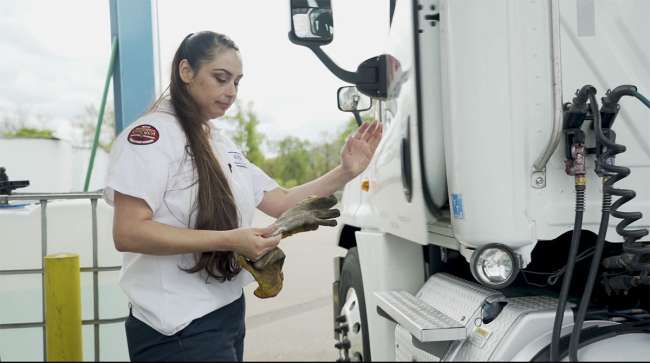Staff Reporter
Oregon Spends $2.1M in Federal Grant to Train Truck Drivers

[Stay on top of transportation news: Get TTNews in your inbox.]
Hundreds of newly minted commercial truck drivers are on the road in Oregon thanks to a state group’s decision to allocate a large chunk of a federal grant to driver training.
The Southwestern Oregon Workforce Investment Board (SOWIB) two years ago spent $2.1 million of a $3.4 million Good Jobs Challenge grant that the U.S. Economic Development Administration allocated as part of an economic rescue funding issued in the wake of the coronavirus pandemic. The state program, called Driving Prosperity, aimed to train more truckers to help overcome the nationwide driver shortage. To date, 360 new commercial truck drivers have been trained.
With SOWIB acting as the project lead, program funding was split among six counties across an 18,000-square-mile area, with an initial goal of training 325 new drivers over two years. That projection proved conservative as demand for the free training was high, said Georgia Conrad, spokesperson for Oregon Workforce Partnerships. In addition to the purchase of two mobile CDL training simulators, funding was spent directly on tuition, fuel and work clothes and shoes for students. The training regimens spanned between four and six weeks.
Across the six counties there was involvement from three state workforce boards, three transportation sector partnerships and seven trucking driving schools. Participation was focused in southern Oregon across Coos, Curry, Douglas Jackson, Josephine and Lane counties.
Trucking Industry from Oregon Workforce Partnership on Vimeo.
Conrad noted that driver training programs often do not qualify for federal aid, so allocation of these funds was viewed as a way to offer candidates a path to a driving career.
“The program has already achieved this milestone and will exceed the program’s expectations by serving an estimated 360 participants by June 30. Each of the three local workforce boards with funds from this grant have fully obligated their money,” Conrad said. “None of these individuals [new drivers] paid out of pocket for their CDL training or for the cost of the license.”
That cost-free training has for now concluded with this effort, however.
Check out Transport Topics' updated Top 100 list of the largest logistics companies in North America, and explore how the industry's top players have adapted to a tough freight market and are preparing for the future. Tune in above or by going to RoadSigns.ttnews.com.
“The funding for this project is fully obligated, and we have not found a sustainable method to continue,” Conrad said. “However, we do still refer people to their local WorkSource Oregon center for enrollment and assist them to skill up or find other avenues.”
Conrad is hopeful that graduates of the program will remain local.
“Students can choose where they want to work and live upon completion of the program,” she said. “Ideally, we want students to stay in our local communities to live and work, but they are under no obligation to the program to do so.”
Meantime, interest among Oregonians to receive driving training remains high, Conrad said. She noted that Oregon’s local workforce training boards have targeted the transportation sector and are helping prospective truck drivers find training and employment using sector partnerships.
“There is much more work to do in the transportation sector,” Conrad said. “We continue to field daily inquiries requesting funding for CDL training, which indicates a strong demand for CDL training. Overall, this high level of interest demonstrates the positive impact and relevance of the program within our community.”
Want more news? Listen to today's daily briefing below or go here for more info:





